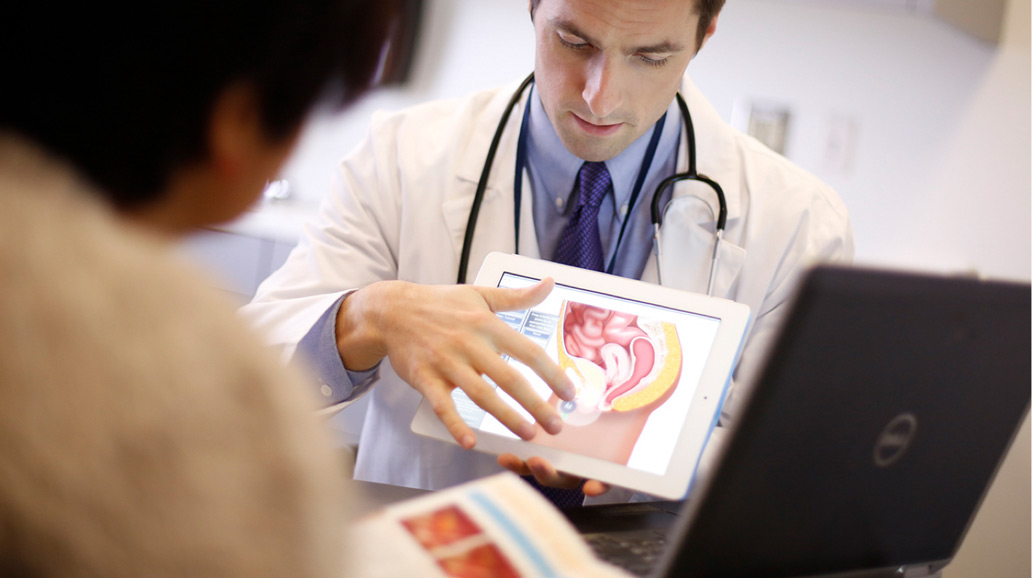Understanding your treatment
When a pelvic organ becomes displaced or slips down in the pelvis, it is referred to as a prolapse. You may have heard women refer to their “dropped bladder” or “fallen uterus.”
There are many reasons for pelvic organ prolapse including pregnancy, childbirth or simply aging.¹ The symptoms can be frustrating, painful and interfere with your daily life. If non-surgical treatments do not provide sufficient relief, speak to a specialist about surgical options available to you.

Sacrocolpopexy/sacrohysteropexy
Sacrocolpopexy is a 2–3 hour surgical procedure using a laparoscopic or robotic surgical instrument to attach a graft between the vaginal apex and the tailbone to correct pelvic organ prolapse.
What to expect
Before
General anesthesia is performed, and you will be asleep for the duration of your procedure.
During
- The physician uses an open, laparoscopic or robotic approach and attaches a graft between the vaginal apex and the tailbone. Depending on the technique used, a hysterectomy (removal of the uterus) may be required.
- Finally, a small camera is used to examine the inside of the bladder to ensure there were no injuries during the surgery.
After
Most likely, after the procedure you will stay in the hospital for at least 1 day. Before your discharge from the hospital, you may be given medications such as stool softeners and pain medications. You will be instructed on how to care for your incision area. At the discretion of your physician, most patients resume moderate activities within 6 to 8 weeks, with no strenuous activity for up to 12 weeks.
Knowing the side effects
Please consult your physician to discuss the associated risk and complications for the specific surgical material you receive. Below are lists of potential adverse events for Boston Scientific's pelvic organ prolapse surgical materials. Potential adverse events, any of which may be ongoing, include but are not limited to: Abscess (swollen area within the body tissue, containing a buildup of pus), Adhesion formation (when a scar extends from within one area to another), Allergic reaction (hypersensitivity) to the implant, Bruising, Bleeding, Constipation, Dehiscence (opening of the incision after surgery), De novo detrusor instability (involuntary contraction of the bladder wall leading to an urge to urinate), Dyspareunia (pain during sexual intercourse) that may not resolve, Sexual dysfunction (difficulty with sexual response, desire, orgasm or pain); including the inability to have intercourse, Erosion into organs; exposure/extrusion into vagina (when the mesh goes through the vagina into other organs or surrounding tissue), Exposed mesh may cause pain or discomfort to the patient’s partner during intercourse, Fistula formation (a hole/passage that develops through the wall of the organs) which may be acute or chronic, Foreign body reaction (body’s inflammatory response to the implant) which may be acute or chronic, Granulation tissue formation (reddish connective tissue that forms on the surface when a wound is healing), Hematoma formation (a pool of blood under the skin/bruising), Hemorrhage (profuse bleeding), Infection, Inflammation (redness, heat, pain or swelling at the surgical site as a result of the surgery) which may be acute or chronic, Injury to ureter (the duct that urine passes from the kidneys to the bladder), Scarring/scar contracture (tightening of the scar), Mesh contracture (mesh shrinkage), Tissue contracture (tightening of the tissue), Necrosis (death of living tissue in a small area), Nerve injury (injury to the nerve fiber), Organ perforation (a hole in or damage to these or other tissues that may happen during placement), Pain: pelvic, vaginal, groin/thigh, dyspareunia—which may become severe, Perforation or laceration of vessels, nerves, bladder, or bowel (a hole in or damage to these or other tissues that may happen during placement), Post-operative bowel obstruction (blockage that keeps food or liquid from passing through the small or large intestines), Prolapse/recurrent prolapse (complete failure of the procedure), Vaginal shortening or stenosis which may result in Dyspareunia and/or Sexual Dysfunction, Voiding dysfunction: incontinence, temporary or permanent lower urinary tract obstruction, difficulty urinating, pain with urination, overactive bladder, and retention (involuntary leakage of urine or reduced or complete inability to empty the bladder). The occurrence of one or more of these complications may require treatment or surgical intervention. In some instances, the complication may persist as a permanent condition after the surgical intervention or other treatment. Removal of mesh or correction of mesh-related complications may involve multiple surgeries. Complete removal of mesh may not be possible and additional surgeries may not always fully correct the complications.
On your way to recovery
Every patient’s recovery experience is unique, and you should consult with your physician as to what he or she expects in your case. Your doctor will determine which kind of anesthesia will be used during your surgery, the length of time you may be hospitalized after the surgery, your need for additional medication following the surgery (for example antibiotics) and whether you will have to go home with a catheter (a flexible plastic tube that drains urine from your bladder). After undergoing prolapse surgery, you may feel sore. Notify your physician immediately if you have pain with urination, bleeding, painful sexual intercourse, severe pain, defecatory problems or other problems after surgery. Please consult with your physician on activities to avoid during recovery:
- Showering for the first 48 hours after the surgery and avoid swimming, soaking or submerging in water for 6 weeks after surgery
- Lifting heavy objects (more than 5 pounds) including pulling or pushing for 4-6 weeks
- Placing anything into the vagina for 6 weeks including tampons, douching, or having
sexual intercourse - Driving for 2 weeks after surgery or while narcotic pain medication is being taken¹